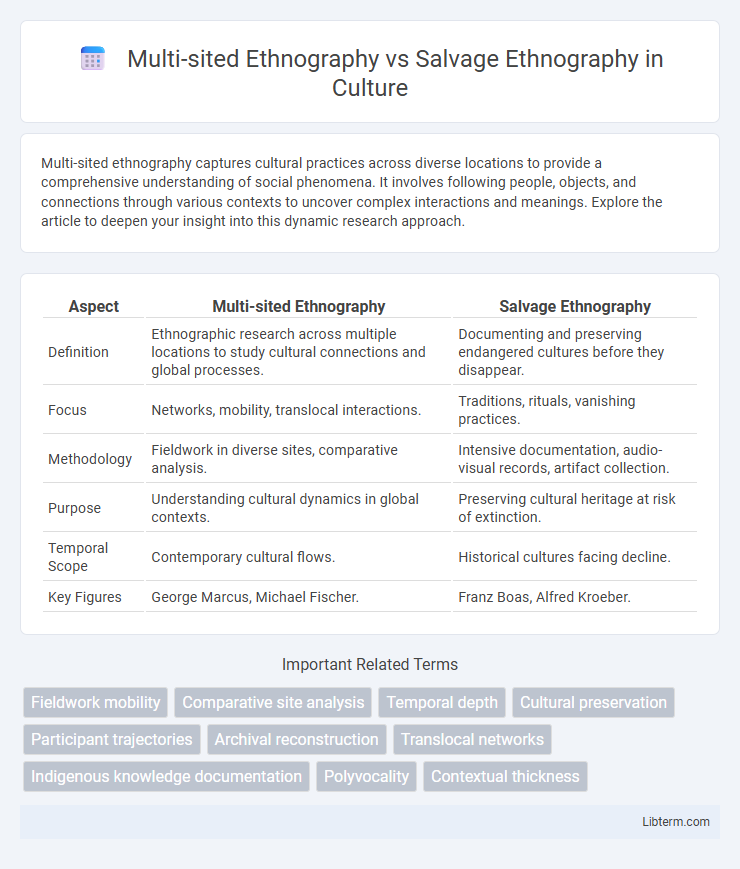Multi-sited ethnography captures cultural practices across diverse locations to provide a comprehensive understanding of social phenomena. It involves following people, objects, and connections through various contexts to uncover complex interactions and meanings. Explore the article to deepen your insight into this dynamic research approach.
Table of Comparison
| Aspect | Multi-sited Ethnography | Salvage Ethnography |
|---|---|---|
| Definition | Ethnographic research across multiple locations to study cultural connections and global processes. | Documenting and preserving endangered cultures before they disappear. |
| Focus | Networks, mobility, translocal interactions. | Traditions, rituals, vanishing practices. |
| Methodology | Fieldwork in diverse sites, comparative analysis. | Intensive documentation, audio-visual records, artifact collection. |
| Purpose | Understanding cultural dynamics in global contexts. | Preserving cultural heritage at risk of extinction. |
| Temporal Scope | Contemporary cultural flows. | Historical cultures facing decline. |
| Key Figures | George Marcus, Michael Fischer. | Franz Boas, Alfred Kroeber. |
Understanding Multi-sited Ethnography
Multi-sited ethnography involves immersive research across multiple locations to analyze cultural phenomena within interconnected social contexts, enhancing the depth and complexity of anthropological insights. Unlike salvage ethnography, which aims to document endangered cultures primarily through static preservation, multi-sited ethnography captures dynamic relationships and translocal movements. This method prioritizes the exploration of global flows, networks, and the impact of globalization on cultural identity.
Defining Salvage Ethnography
Salvage Ethnography focuses on documenting and preserving cultural practices, languages, and traditions at risk of disappearing due to colonization, modernization, or globalization. Unlike Multi-sited Ethnography, which explores interconnected social phenomena across various locations, Salvage Ethnography emphasizes recording endangered cultures in their original contexts before they vanish. This approach often involves detailed collection of artifacts, oral histories, and rituals to safeguard intangible heritage.
Historical Context of Both Approaches
Multi-sited ethnography emerged in the late 20th century as a response to globalization, emphasizing the study of social phenomena across multiple interconnected locations to capture complex cultural flows. Salvage ethnography, prominent in the early to mid-20th century, focused on documenting endangered indigenous cultures perceived as disappearing due to colonialism and modernization. The historical context of multi-sited ethnography reflects shifts in anthropological theory toward transnationalism, while salvage ethnography arose from a colonial-era urgency to preserve what was seen as vanishing human heritage.
Key Methodological Differences
Multi-sited ethnography involves conducting fieldwork across multiple geographic locations to capture diverse cultural practices, emphasizing interconnectedness and the flow of social phenomena across sites. Salvage ethnography focuses on documenting and preserving threatened or rapidly disappearing cultures within a single, often isolated, community, using immersive observation and detailed recording methods. The key methodological difference lies in multi-sited ethnography's translocal approach versus salvage ethnography's concentrated effort on cultural preservation in specific, endangered contexts.
Theoretical Foundations Compared
Multi-sited ethnography builds on George Marcus's theory of following connections, relationships, and power dynamics across multiple locations to understand cultural phenomena in a globalized world. Salvage ethnography, rooted in early anthropological practice, aims to document and preserve cultures perceived as vanishing, often emphasizing static traditions and native artifacts. Theoretically, multi-sited ethnography challenges bounded cultural narratives by highlighting fluidity and translocal interactions, while salvage ethnography is grounded in the primitivist notion of culture as fixed and endangered.
Research Objectives and Outcomes
Multi-sited ethnography aims to explore cultural phenomena across multiple locations to understand complex global connections and networks, producing comprehensive insights into transnational interactions and social processes. Salvage ethnography focuses on documenting disappearing cultures and traditions, preserving knowledge of endangered societies before they vanish, resulting in detailed archival records and ethnographic descriptions. The research objectives of multi-sited ethnography emphasize interlinked social dynamics, whereas salvage ethnography prioritizes cultural preservation and historical documentation.
Ethical Considerations in Each Approach
Multi-sited ethnography demands continuous ethical reflexivity as researchers navigate diverse cultural contexts, ensuring informed consent and respect for local norms across multiple sites. Salvage ethnography often raises ethical concerns related to the potential exploitation of marginalized communities and the risk of misrepresentation while attempting to document cultures perceived as "vanishing." Both approaches require stringent adherence to ethical guidelines, emphasizing transparency, participant autonomy, and cultural sensitivity to uphold research integrity.
Critiques and Controversies
Multi-sited ethnography faces critiques regarding its potential to dilute cultural specificity and fragment local contexts by analyzing dispersed, interconnected sites, which can lead to superficial engagement. Salvage ethnography is controversial for its colonial undertones and portrayal of cultures as vanishing relics, often preserving narratives through a Western lens that can marginalize indigenous voices. Both approaches spark debates on ethical implications, representation, and the balance between comprehensive analysis and authentic, localized understanding.
Impact on Contemporary Anthropological Practice
Multi-sited ethnography revolutionizes contemporary anthropological practice by enabling researchers to trace cultural phenomena across multiple locations, reflecting globalization's complex interconnections. Salvage ethnography, historically aimed at preserving rapidly disappearing cultures, faces criticism for its static portrayal of societies but continues to inform ethical considerations in documentation and representation. The interplay between these approaches shapes anthropological methods that balance dynamic cultural flows with ethical responsibilities in documenting human diversity.
Choosing the Right Ethnographic Approach
Choosing the right ethnographic approach depends on research goals: Multi-sited ethnography traces cultural phenomena across interconnected locations to capture complexity and translocal interactions, while salvage ethnography aims to document endangered cultures before they disappear. Researchers prioritize multi-sited ethnography when exploring dynamic social processes distributed over multiple sites; salvage ethnography is suitable for preserving knowledge of threatened or rapidly changing traditional societies. Both approaches require careful consideration of fieldwork scope, ethical implications, and data triangulation methods to ensure comprehensive and respectful cultural representation.
Multi-sited Ethnography Infographic

 libterm.com
libterm.com